|
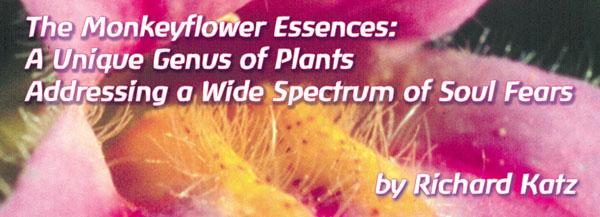
Mimulus
Mimulus guttatus
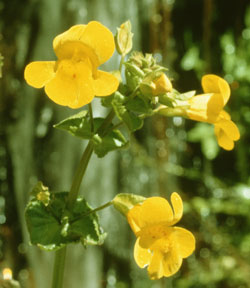 Mimulus
guttatus
is native to the Western United States, and was
naturalized in Britain in the early nineteenth century. In the U.S.
it is found in
a wide range of moist habitats, from coastal meadows and streams
to steep, seeping slopes fed by high mountain snow melt. One of the
first
flower
essences Dr. Edward Bach developed was
Mimulus guttatus
, the
Common or Seep-Spring Monkeyflower, prepared in 1928 along the River
Usk
near the
Welsh border town of Crickhowell. Mimulus grows in wet meadows and
along streambeds. Once abundant along Britain’s waterways,
Mimulus is now much more rare. It is not tolerant of the chemical
pollution
from
farm runoff and domestic detergents, because it requires clean, well-oxygenated
water.
Mimulus
guttatus
is native to the Western United States, and was
naturalized in Britain in the early nineteenth century. In the U.S.
it is found in
a wide range of moist habitats, from coastal meadows and streams
to steep, seeping slopes fed by high mountain snow melt. One of the
first
flower
essences Dr. Edward Bach developed was
Mimulus guttatus
, the
Common or Seep-Spring Monkeyflower, prepared in 1928 along the River
Usk
near the
Welsh border town of Crickhowell. Mimulus grows in wet meadows and
along streambeds. Once abundant along Britain’s waterways,
Mimulus is now much more rare. It is not tolerant of the chemical
pollution
from
farm runoff and domestic detergents, because it requires clean, well-oxygenated
water.
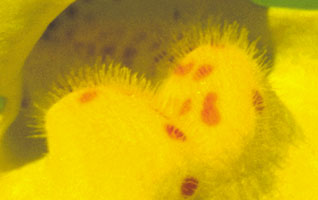 The radiant yellow color of the flower (enlivened by bright red spots),
and its strong affinity to flowing water, suggests an outgoing quality,
and a release of congested emotions. Indeed, Mimulus is indicated
for the specific worries and fears that can vex us in everyday
life,
from the child’s
fear of the dark, to adolescent shyness, to the timidity of an elderly
shut-in. We also see in the names of this plant — the English
Monkeyflower and the Latin
Mimulus
(from “mime”),
that there is a light-hearted, joyful quality that many people feel
in this flower, suggesting one way
of facing life’s challenges.
The radiant yellow color of the flower (enlivened by bright red spots),
and its strong affinity to flowing water, suggests an outgoing quality,
and a release of congested emotions. Indeed, Mimulus is indicated
for the specific worries and fears that can vex us in everyday
life,
from the child’s
fear of the dark, to adolescent shyness, to the timidity of an elderly
shut-in. We also see in the names of this plant — the English
Monkeyflower and the Latin
Mimulus
(from “mime”),
that there is a light-hearted, joyful quality that many people feel
in this flower, suggesting one way
of facing life’s challenges.
Scrophulariaceae plant family
The Mimulus genus
is a member of the
Scrophulariaceae plant family
, which also includes
the Penstemons, Indian Paintbrush, Snapdragon
and Mullein.
In these flowers we do not find the cosmic star-like shape of
daisies or roses. Rather, the flowers are horizontal, mouth-like with
human/animal-like
bilateral symmetry, and vibrant colors. These blossoms create
an inner space, like human or animal organs, in which soul forces
can be contained
and experienced. Essences from the Scrophulariaceae family address
intense emotions, such as fear or anger, which are registered
within the deep
recesses
of the psyche and corresponding physical organs. Such emotions
are colorfully described as “gut-level feelings,” and
are often correlated with disturbances in the metabolic region
of the
body.
Within the Scrophulariaceae family, the
Mimulus
genus
— also
called the
Monkeyflowers
— has an abundance of different
species (approximately 150 world-wide, with at least 40 native
to California). These flowers are
characterized by their mouth-like shape, a “throat” that
flares into two upper and three lower petals. Essences from
four of these Monkeyflowers
are now in common use as FES flower essences, expanding the
Mimulus theme of moving through fear. Just as the various species
within
the genus
are variations on a botanical theme, the various essences made
from the Monkeyflowers
explore related issues of fear and taking hold of life. They
form a spectrum of colors: pink, red, orange, yellow and purple,
that
can
clearly be
associated with the specific emotional centers in the mind-body
complex:
 The bright yellow
Mimulus
– related to fears
typically associated with the solar plexus
The bright yellow
Mimulus
– related to fears
typically associated with the solar plexus
 Scarlet
Monkeyflower
– addresses
levels of fear related to anger or a lack of power and
self-identity
most often associated
with the
first chakra
Scarlet
Monkeyflower
– addresses
levels of fear related to anger or a lack of power and
self-identity
most often associated
with the
first chakra
 Purple Monkeyflower
– is indicated
for fears stemming from religious or spiritual belief systems
that may affect the higher
chakras, especially
the crown
Purple Monkeyflower
– is indicated
for fears stemming from religious or spiritual belief systems
that may affect the higher
chakras, especially
the crown
 Sticky Monkeyflower
– this soft orange
flower is related to issues of intimacy and sexuality,
typically associated with the second
chakra
Sticky Monkeyflower
– this soft orange
flower is related to issues of intimacy and sexuality,
typically associated with the second
chakra

Pink Monkeyflower
– this
pink flower that grows in riparian habitats nurtures the heart
and heals levels of fear and shame hidden
in this energy center
Scarlet Monkeyflower
Mimulus
cardinalis
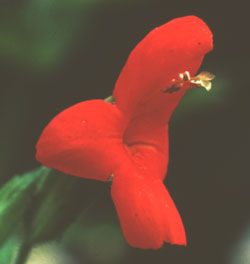 Like
Dr. Bach’s Mimulus, Scarlet Monkeyflower
is found along streams and in moist meadows. It is not as widespread
as the common Monkeyflower,
but it is found throughout the western U.S.,
particularly in California and southern Oregon. With its brilliant
scarlet to
red-orange flowers, swept-back
petals and protruding stamens, this flower radiates
an unusual intensity and strength. The wide-open “mouth” of
its inflorescence seems to suggest a strong intensity and release
of deep red vital
forces.
Like
Dr. Bach’s Mimulus, Scarlet Monkeyflower
is found along streams and in moist meadows. It is not as widespread
as the common Monkeyflower,
but it is found throughout the western U.S.,
particularly in California and southern Oregon. With its brilliant
scarlet to
red-orange flowers, swept-back
petals and protruding stamens, this flower radiates
an unusual intensity and strength. The wide-open “mouth” of
its inflorescence seems to suggest a strong intensity and release
of deep red vital
forces.
Scarlet Monkeyflower addresses issues of anger
and power, and is often associated with the lower,
or
survival chakra.
The
flower essence helps
one to recognize anger at an early stage, rather
than to repress it until it builds up into uncontrollable
rage.
In general,
this essence
deals
with the “shadow” side of the personality,
those deep and dark feelings that one fears,
but which can contain much of one’s vitality
and power. Thus, people needing Scarlet Monkeyflower
often seem pale, weak — lacking “red
energy” — although more powerful
or explosive feelings can remain hidden or unacknowledged.
Sticky
Monkeyflower
Mimulus aurantiacus
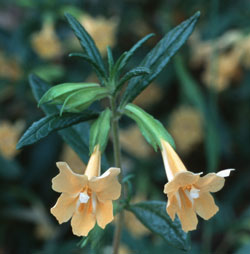 This species
is a bush Monkeyflower, a sub-group of the Mimulus genus that grows
in a drier
habitat, with
a woody,
perennial
growth pattern,
compared
to the more herbaceous annual habit of other
Mimulus species. Some botanists even place
these species
in a separate genus,
Diplacus
.
Sticky Monkeyflower
is named for the resinous leaves, a quality
that is typical of plants in the sunny, dry
hillsides
where
it is found.
Its habitat
ranges
from Oregon
south through California, and it is particularly
abundant in the central California coastal
hills. There are
many variations in
the flower color,
from red to orange to pale salmon. The gentle
orange flowers, the most common form, are
used for the
FES essence. The
plant flowers
from mid-spring
into the summer. Both the flowers and leaves
typically grow in opposite pairs.
This species
is a bush Monkeyflower, a sub-group of the Mimulus genus that grows
in a drier
habitat, with
a woody,
perennial
growth pattern,
compared
to the more herbaceous annual habit of other
Mimulus species. Some botanists even place
these species
in a separate genus,
Diplacus
.
Sticky Monkeyflower
is named for the resinous leaves, a quality
that is typical of plants in the sunny, dry
hillsides
where
it is found.
Its habitat
ranges
from Oregon
south through California, and it is particularly
abundant in the central California coastal
hills. There are
many variations in
the flower color,
from red to orange to pale salmon. The gentle
orange flowers, the most common form, are
used for the
FES essence. The
plant flowers
from mid-spring
into the summer. Both the flowers and leaves
typically grow in opposite pairs.
Sticky Monkeyflower addresses issues of the
second chakra, sexuality and relationship,
the fear
of the orange energy
of warmth and
connection. It
is typically indicated for those who have
had hurtful experiences in relationships
and fear
intimacy.
Their sexuality may
be repressed, or acted out in a
way that is disconnected from the heart.
The lesson of the Sticky Monkeyflower is
to experience
sexuality
and
intimacy
as a true,
caring, heart connection.
Pink Monkeyflower
Mimulus lewisii
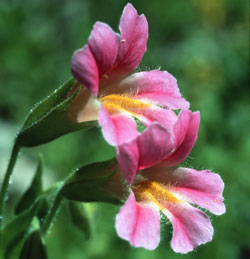 Named
for Captain Meriwether Lewis of the famous Lewis and Clark expedition,
Lewis
Monkeyflower
is found in
the Sierra
Nevada,
Cascade and Rocky Mountain
ranges of the western U.S. It is a
large-flowered Mimulus, found along mountain seeps and
streams. The flowers,
typically in pairs,
are pink with
darker rose-colored areas, and yellow
hairy ridges on the lower petals. The shape and
size of the
flowers resemble
the Sticky
(Bush) Monkeyflower,
but its herbaceous nature and moist habitat
are more closely
aligned with the Scarlet and Seep-Spring
Monkeyflowers (Mimulus cardinalis
and
M.
guttatus).
Named
for Captain Meriwether Lewis of the famous Lewis and Clark expedition,
Lewis
Monkeyflower
is found in
the Sierra
Nevada,
Cascade and Rocky Mountain
ranges of the western U.S. It is a
large-flowered Mimulus, found along mountain seeps and
streams. The flowers,
typically in pairs,
are pink with
darker rose-colored areas, and yellow
hairy ridges on the lower petals. The shape and
size of the
flowers resemble
the Sticky
(Bush) Monkeyflower,
but its herbaceous nature and moist habitat
are more closely
aligned with the Scarlet and Seep-Spring
Monkeyflowers (Mimulus cardinalis
and
M.
guttatus).
Pink Monkeyflower deals with the delicate
feelings of vulnerability of the heart,
the feelings
of shame that
cause one to withdraw
and fear contact
with others. Think of the pink blush
of embarrassment, the uncomfortable flush
of the face when
we fear exposure. The
shame may be sexual
in origin, or a more existential sense
of unworthiness. Pink Monkeyflower teaches
us to have the courage to take the risk
to
touch and be touched by others, emotionally
and physically.
Purple Monkeyflower
Mimulus
kelloggii
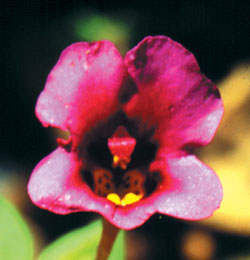 Kellogg’s Monkeyflower is found in moist fields and slopes in the foothills of the Sierra Nevada and Cascade mountains, up to about 3,000 feet of elevation. It is a small plant, which typically grows in dense mats, flowering during the spring before the summer drought sets in. These flowers have an intense red-purple color, with a deep, dark interior. Kellogg’s Monkeyflower is found in moist fields and slopes in the foothills of the Sierra Nevada and Cascade mountains, up to about 3,000 feet of elevation. It is a small plant, which typically grows in dense mats, flowering during the spring before the summer drought sets in. These flowers have an intense red-purple color, with a deep, dark interior.
Purple Monkeyflower essence addresses fears of the upper chakras, namely our relationship to spirituality, religion, and religious authority. The purple color has an association with ecclesiastical hierarchy, as its densely clustered growth habit suggests enmeshment in a group identity. This essence has proven beneficial for those who fear religious judgment or have turned away from spirituality out of reaction to fear-based religion. The lesson of the Purple Monkeyflower is to have the courage to find one’s own genuine spiritual path, whether that be a new quest for meaning, or a renewal of one’s religious roots.
Thus we see that the colorful kaleidoscope of Monkeyflower essences addresses a wide spectrum of soul fears, giving us courage and strength to step boldly into life, confident we have the forces to meet any challenge.
|

![]() and then Add to Home Screen.
and then Add to Home Screen.
![]() and then Add to Home Screen.
and then Add to Home Screen.